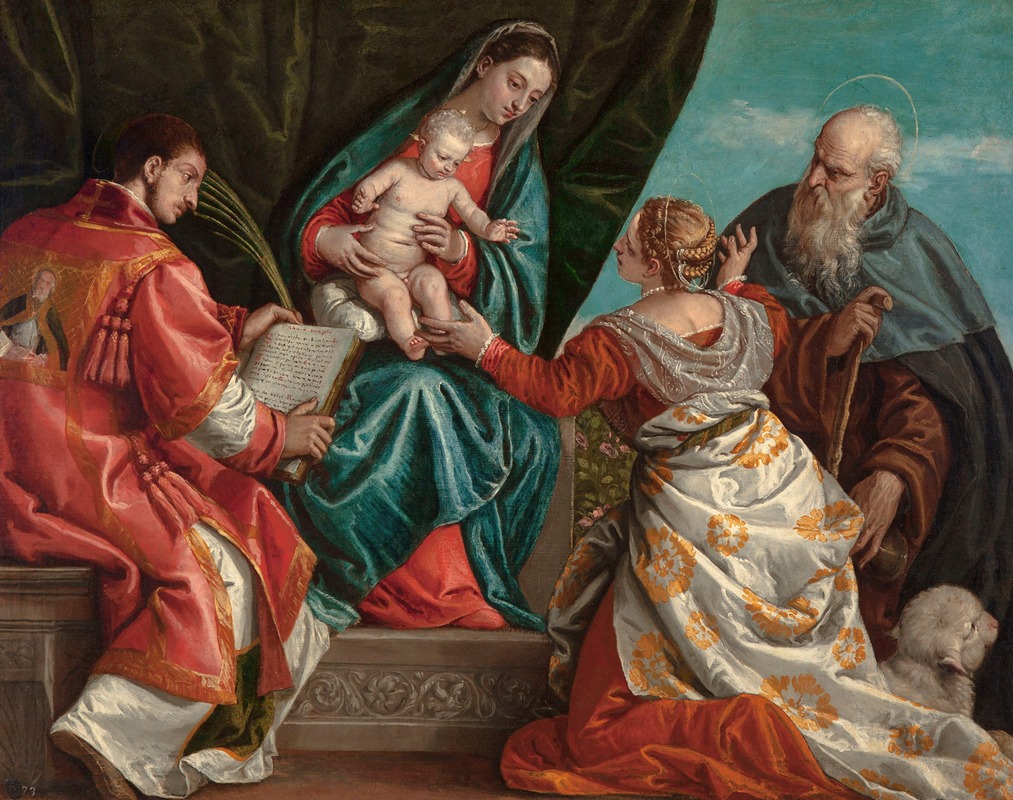
Sacra Conversazione
A hand-painted replica of Paolo Veronese’s masterpiece Sacra Conversazione, meticulously crafted by professional artists to capture the true essence of the original. Each piece is created with museum-quality canvas and rare mineral pigments, carefully painted by experienced artists with delicate brushstrokes and rich, layered colors to perfectly recreate the texture of the original artwork. Unlike machine-printed reproductions, this hand-painted version brings the painting to life, infused with the artist’s emotions and skill in every stroke. Whether for personal collection or home decoration, it instantly elevates the artistic atmosphere of any space.
Paolo Veronese, an Italian Renaissance painter, is renowned for his large-scale historical and religious paintings, characterized by their vibrant color, intricate compositions, and dramatic use of perspective. One of his notable works is "Sacra Conversazione," a theme that was popular among Renaissance artists, depicting the Virgin Mary and Child Jesus in conversation with saints.
The term "Sacra Conversazione" translates to "Holy Conversation" in English and refers to a genre of Christian art that portrays the Virgin and Child surrounded by a group of saints, often in a unified, harmonious setting. This genre became prominent during the Renaissance as artists sought to create more dynamic and engaging religious scenes that encouraged contemplation and devotion.
Veronese's interpretation of the Sacra Conversazione theme is distinguished by his masterful use of color and light, as well as his ability to create a sense of grandeur and opulence. His works often feature elaborate architectural settings, rich fabrics, and a keen attention to detail, all of which are evident in his depiction of the holy figures.
In Veronese's "Sacra Conversazione," the composition typically includes the Virgin Mary seated with the Christ Child on her lap, surrounded by various saints who are engaged in a serene and contemplative interaction. The saints are often identifiable by their attributes or symbols, which Veronese skillfully incorporates into the painting to convey their identities and stories. The figures are arranged in a way that creates a sense of balance and harmony, a hallmark of Veronese's style.
Veronese's use of color is particularly noteworthy in this work. He employs a rich palette, with vibrant reds, blues, and golds that draw the viewer's eye and enhance the overall sense of divinity and majesty. The interplay of light and shadow adds depth and dimension to the scene, highlighting the figures and their expressions, and creating a sense of movement and life within the painting.
The architectural elements in Veronese's "Sacra Conversazione" are also significant. He often places the figures within grand, classical settings, featuring columns, arches, and other architectural details that lend a sense of timelessness and stability to the composition. This not only frames the figures but also serves to elevate the spiritual significance of the scene.
Veronese's ability to blend the sacred with the everyday is another aspect that makes his work stand out. While the figures are depicted in a divine context, there is a sense of accessibility and relatability in their expressions and gestures, inviting the viewer to engage with the scene on a personal level.
Overall, Paolo Veronese's "Sacra Conversazione" exemplifies the artist's skill in creating visually stunning and spiritually profound works of art. His ability to combine color, composition, and narrative into a cohesive and compelling whole has made his interpretation of the Sacra Conversazione theme a lasting contribution to the canon of Renaissance art. Through this work, Veronese not only demonstrates his technical prowess but also his deep understanding of the religious and cultural significance of the subjects he portrays.







